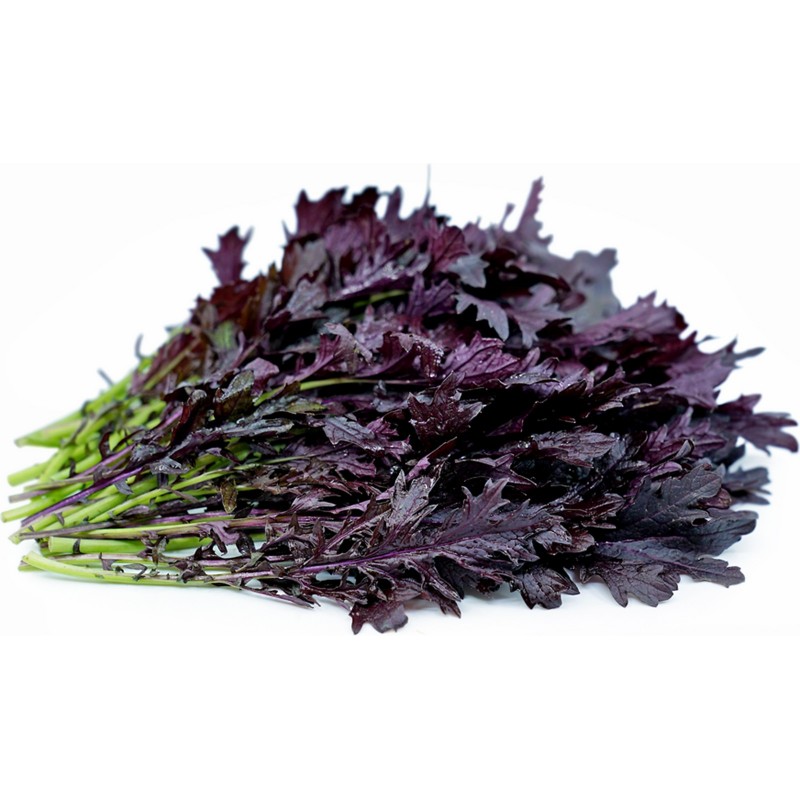Mizuna Red Japenese Mustard Seeds
Price for a Package of 10 seeds.
'Mizuna' has been cultivated in Japan since ancient times. Mizuna was successfully grown in the International Space Station in 2019. It grows in hardiness zones 4 to 9, prefers full sun or partial shade, well-drained soil, and has a pH of 6.5-7.0. It can be grown as a microgreen, or for its leaves with a 20cm spacing.
The mizuna is native to the maritime areas of northern China, Korea, and Japan. It is also one of the plants called "Kyo-Yasai", those whose excellent flavor explained that they were traditionally cultivated for the emperor in the former imperial city, around Kyoto. Mizuna, introduced after World War II in the United States and then in Europe, quickly established itself there.
It is a hardy, biennial plant. It offers a yellow flowering (small flowers with 4 petals like all those of the representatives of the Brassicaceae family) the year following that of its
sowing. In the first year, the mizuna develops a dense rosette, 15 to 25 cm high, with numerous elongated, finely cut, light green leaves. This
cabbage can evoke both curly
chicory and a tuft of dandelion. The foliage of the mizuna is crunchy and has a slightly peppery flavor. This certainly explains the nickname "Japanese
mustard" which sometimes designates this
cabbage.
Culinary uses of mizuna
Mizuna is of course used in salads or, finely chopped, it can be quickly returned to a wok or slipped into soups and stews.
For example, sliced leaves can be quickly pan-fried and served with shrimp and pasta. To test: sprinkle the dish with coconut milk, sprinkle it with roasted peanuts.
Mizuna can also be cooked in poultry or beef broth. Or be prepared as a pesto as you do with arugula.
Mizuna is the basis of a popular Kyoto culinary specialty: Japanese duck and mizuna fondue.
Another “Kyo Yasai”
vegetable, komatsuna is widely consumed in Japanese restaurants and in Korean cuisine. It is traditionally prepared there in namuru: a sauce made from sesame oil and kochujan (a slightly sweet and fermented chili paste).
Mizuna
sowing Mizuna is undemanding: if it prefers soils that remain cool but well-drained, it can grow in any good garden soil. Choose a sunny location.
Hardy (it resists temperatures down to -12 ° C), it is however sensitive to heat which can cause its rise to seeds prematurely. Also, although it can be sown in place as early as May, prefer to grow it in late summer (late August) for a winter harvest.
Mizuna is sown in open ground nurseries or in place. The plants are thinned and transplanted when they have 4 leaves, spacing them 20 cm.
Rustic, healthy, and vigorous, this
vegetable requires almost no maintenance: neither fertilization nor treatment. Grown in autumn and winter, it also does not require watering. You just have to take care to protect your rosettes under a wintering sail if the outside temperatures become very low and persist for several days.
Mizuna can be harvested 6 weeks after
sowing.
Common name: Mizuna
Latin name: Brassica rapa var japonica
Family: Brassicaceae
Vegetation: Biennial
Mature height: 0.15 to 0.30 m
Soil type: Clayey soil Limestone soil Sandy soil Humus










 Reviews (0)
Reviews (0)